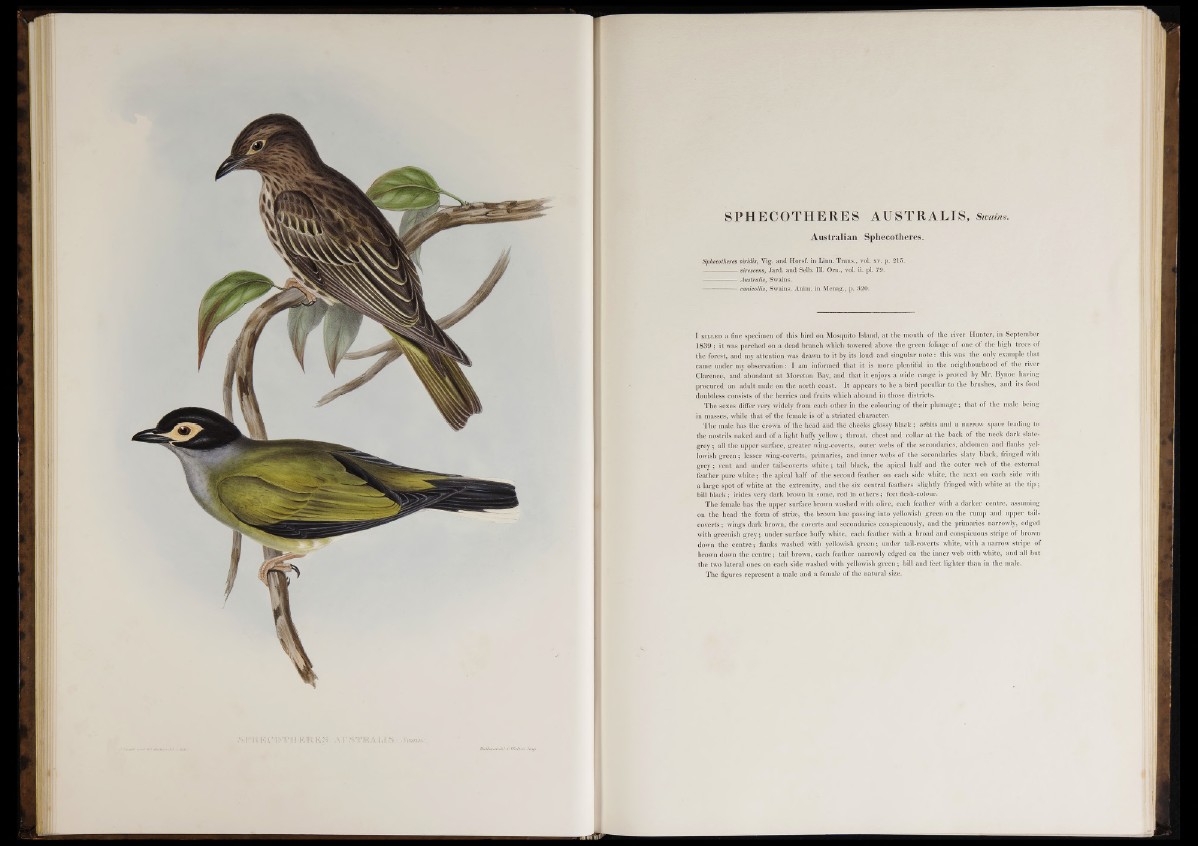
SPHECOTHERES AUSTRALIS, Swains.
Australian Sphecotheres.
Sphecotheres viridis, Vig. and Horsf. in Linn. Trans., vol. xv. p. 215.
--------------- virescens, Jard. and Selb. 111. Om., vol. ii. pi, 79.
—------------ Australis, Swains.
canicollis, Swains. Anim. in Menag., p. 320.
I kilt/BP a fine specimen of this bird on Mosquito Island, at the mouth of the river Hunter, in September
1839; it was perched on a dead branch which towered above the green foliage of one of the high trees of
the forest, and my attention was drawn to it by its loud and singular note: this was the only example that
came under my observation: I am informed that it is more plentiful in the neighbourhood of the river
Clarence, and abundant at Moreton Bay, and that it enjoys a wide range is proved by Mr. Bynoe having
procured an adult male on the north coast. It appears to be a bird peculiar to the brushes, and its food
doubtless consists of the berries and fruits which abound in those districts.
The sexes differ very widely from each other in the colouring of their plumage; that of the male being
in masses, while that of the female is o f a striated character.
The male has the crown of the head and the cheeks glossy black; orbits and a narrow space leading to
the nostrils naked and of a light huffy yellow ; throat, chest and collar at the back of the neck dark slate-
grey ; all the upper surface, greater wing-coverts, outer webs of the secondaries, abdomen and flanks yellowish
green; lesser wing-coverts, primaries, and inner webs of the secondaries slaty black, fringed with
grey; vent and under tail-coverts white; tail black, the apical half and the outer web of the. external
feather pure white; the apical half of the second feather on each side white, the next on each side with
a large spot of white at the extremity, and the six central feathers slightly fringed with white at the tip ;
bill black; irides very dark brown in some, red in others; feet flesh-colour.
The female has the upper surface brown washed with olive, each feather with a darker centre, assuming
on the head the form of striae, the brown hue passing into yellowish green on the rump and upper tail-
coverts ; wings dark brown, the coverts and secondaries conspicuously, and the primaries narrowly, edged
with greenish grey; under surface buffy white, each feather with a broad and conspicuous stripe of brown
down the centre; flanks washed with yellowish green; under tail-coverts white, with a narrow stripe of
brown down the centre; tail brown, each feather narrowly edged on the inner web with white, and all but
the two lateral ones on each side washed with yellowish green; bill and feet lighter than in the male.
The figures represent a male and a female of the natural size.